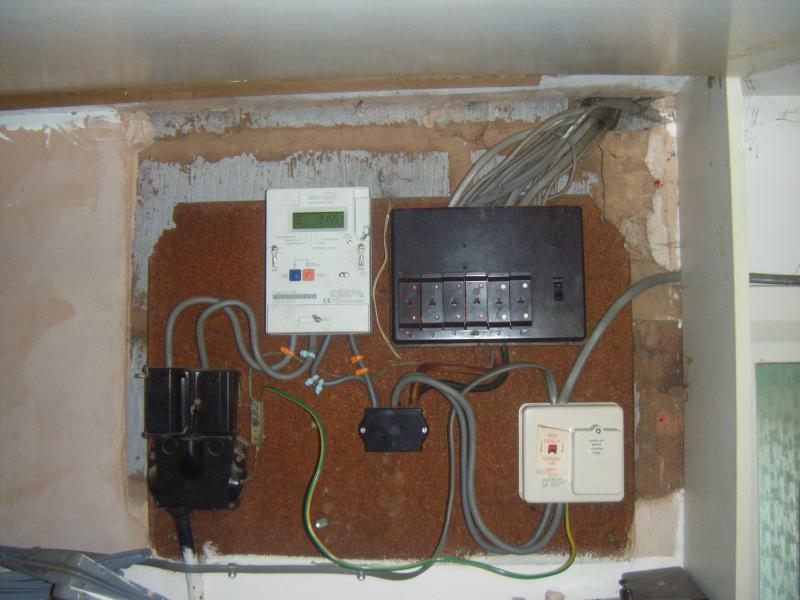Hello all,
I’m hoping you can help me specify suitable consumer unit to replace the existing one.
The photo below shows the current arrangement.
The incoming feed and main fuse box date from mid 60’s when the house was built. The house was extended in the mid 70’s and again in the mid 80’s and it seems that the extra wiring was squeezed into the original fuse box. The only exception was a feed to an electric shower and a double socket in the utility room fed from a separate isolator mounted under the fuse board.
I’m about to have a kitchen extension built and I presume the new wiring for this as well as the current kitchen wiring changes are going to necessitate a new consumer unit to replace the current original fuse box.
My fear is that the various vintages of current wiring around the house may fall short with the demands of a modern RCD protected consumer unit and that what has started as a kitchen extension may escalate into a more comprehensive house re-wiring exercise.
I certainly like the idea of separating out the current mass of wiring into individual circuits on a new consumer unit and should this expose a particular bad/poor circuit then look to address this.
Is it possible/allowable to have non RCD protected elements – e.g specific circuit for fridge/freezer or for a circuit that is borderline and would otherwise keep tripping an RCD.
Are there any recommendations for the consumer unit I ask the electrician whose doing the new extension wiring to fit. I’d ideally like something flexible to have as much control over the individual circuits as possible and hopefully RCD them all but have the option not to.
Finally as you can see, when the smart meter was fitted I foolishly didn’t have an isolator installed after the meter and ideally should have had the meter installed in such a way as to leave space for a new consumer unit.
What’s the recommended route to getting the meter moved 6” and an isolator switch installed – I gather there is a high risk of breaking the fuse in the PME if it is removed – can I ask EON (my regional company) to change/upgrade this or should I ask EON (also my supply company) to move the meter and install a switch? Presumably the electrician can’t just move the meter and do this without breaking seals?
Thanks in advance for any assistance/recommendations
Phil
I’m hoping you can help me specify suitable consumer unit to replace the existing one.
The photo below shows the current arrangement.
The incoming feed and main fuse box date from mid 60’s when the house was built. The house was extended in the mid 70’s and again in the mid 80’s and it seems that the extra wiring was squeezed into the original fuse box. The only exception was a feed to an electric shower and a double socket in the utility room fed from a separate isolator mounted under the fuse board.
I’m about to have a kitchen extension built and I presume the new wiring for this as well as the current kitchen wiring changes are going to necessitate a new consumer unit to replace the current original fuse box.
My fear is that the various vintages of current wiring around the house may fall short with the demands of a modern RCD protected consumer unit and that what has started as a kitchen extension may escalate into a more comprehensive house re-wiring exercise.
I certainly like the idea of separating out the current mass of wiring into individual circuits on a new consumer unit and should this expose a particular bad/poor circuit then look to address this.
Is it possible/allowable to have non RCD protected elements – e.g specific circuit for fridge/freezer or for a circuit that is borderline and would otherwise keep tripping an RCD.
Are there any recommendations for the consumer unit I ask the electrician whose doing the new extension wiring to fit. I’d ideally like something flexible to have as much control over the individual circuits as possible and hopefully RCD them all but have the option not to.
Finally as you can see, when the smart meter was fitted I foolishly didn’t have an isolator installed after the meter and ideally should have had the meter installed in such a way as to leave space for a new consumer unit.
What’s the recommended route to getting the meter moved 6” and an isolator switch installed – I gather there is a high risk of breaking the fuse in the PME if it is removed – can I ask EON (my regional company) to change/upgrade this or should I ask EON (also my supply company) to move the meter and install a switch? Presumably the electrician can’t just move the meter and do this without breaking seals?
Thanks in advance for any assistance/recommendations
Phil


